Welcome to the Janison Insights help portal
Reporting
This reporting functionality provides the ability to create and run detailed reports on key entities in the system, including item or answer, and using filters such as status. This allows you to customise and generate professional reports with minimal input.
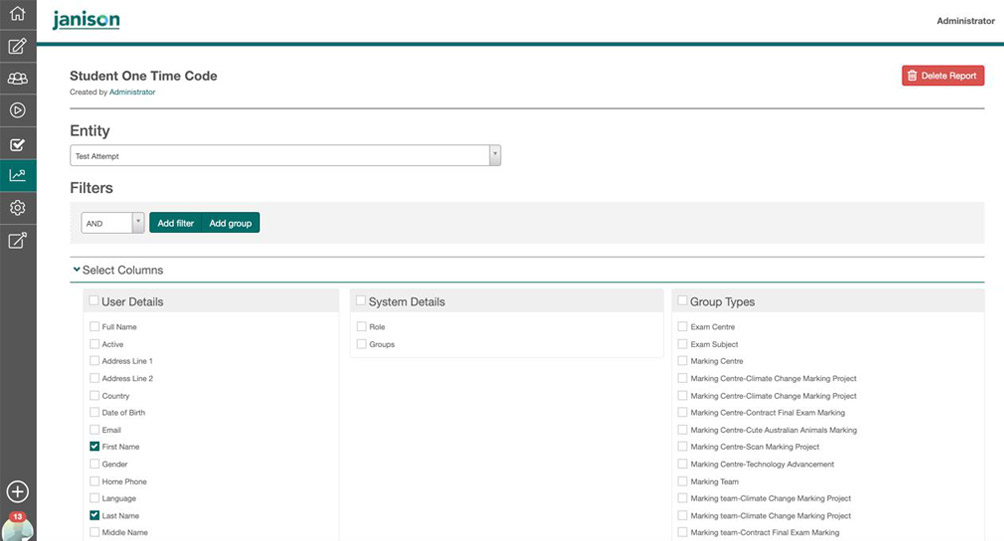
Custom report settings can be saved so reports can be run at a later date with all the filters and columns already selected.
Reports can also be set to run automatically on a defined schedule and you can choose who can view and edit the report.
There are various settings available which enable or disable custom report options and fields. To access these settings, select the Settings button.
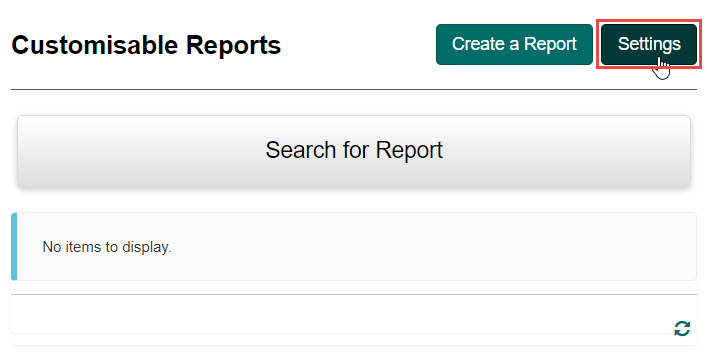
The following settings are available:
| # | Item | Description |
|---|---|---|
| A | Enable Excel Template based reports | This setting enables you to apply templates to reports which gives you additional features such as adding pivot tables to create charts and do data counts. To learn more about this, see the Custom report templates section. |
| B | Enable private reports | This setting impacts the options available in the popup when saving a report. Select this setting to enable a Scope field which allows you to select who is permitted to access the report. 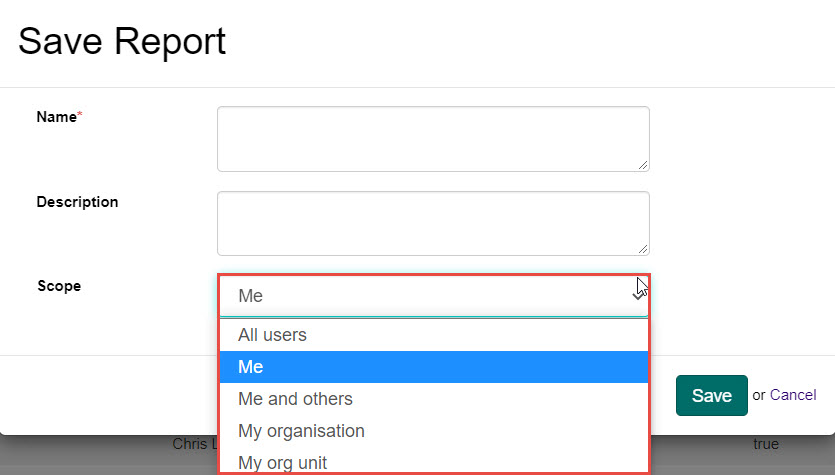 |
| C | Enable selective sharing of reports | This setting impacts the options available in the popup when saving a report. Select this setting to enable a filter when Me and others is selected from the Scope drop-down. This enables you to specify Users who are permitted to access the report.  |
| D | Enable ordering of groups for User and Enrolment entities | This setting forces the Group column to display in alphabetical order based on the Group ID. Tip This may introduce a performance issue to the report. |
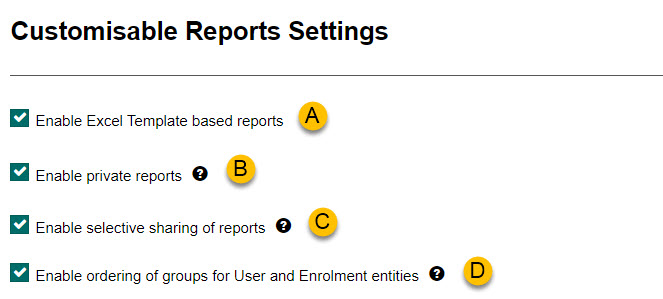
The settings in the Enabled entity types expandable section allow you to control whether entity types are available for selection when creating a report.
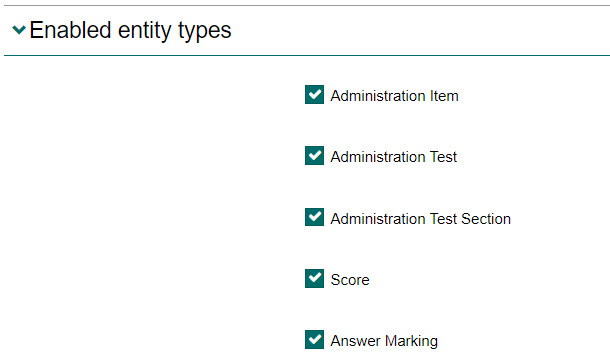
Customisable reports can be accessed by selecting Reports from the Menu, then selecting Customisable Reports.

There are various settings available which enable or disable custom report options and fields. To access these settings, select the Settings button.

The following settings are available:
| # | Item | Description |
|---|---|---|
| A | Enable Excel Template based reports | This setting enables you to apply templates to reports which gives you additional features such as adding pivot tables to create charts and do data counts. To learn more about this, see the Custom report templates section. |
| B | Enable private reports | This setting impacts the options available in the popup when saving a report. Select this setting to enable a Scope field which allows you to select who is permitted to access the report.  |
| C | Enable selective sharing of reports | This setting impacts the options available in the popup when saving a report. Select this setting to enable a filter when Me and others is selected from the Scope drop-down. This enables you to specify Users who are permitted to access the report.  |
| D | Enable ordering of groups for User and Enrolment entities | This setting forces the Group column to display in alphabetical order based on the Group ID. Tip This may introduce a performance issue to the report. |

The settings in the Enabled entity types expandable section allow you to control whether entity types are available for selection when creating a report.

Once you have created a custom report, you have the option to save the report.
Tip
This is only necessary if you intend to run the report again in the future.
To save a report:
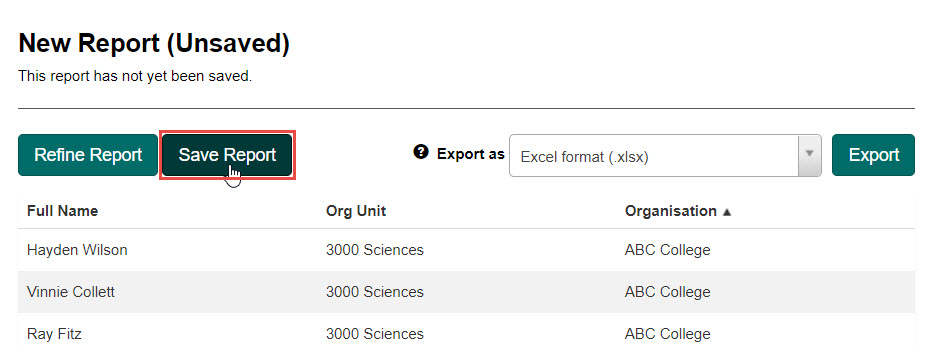
A popup will display.
Tip
This popup may differ depending on the settings enabled. See the Custom report settings section for more information.
Complete the following:
Tip
Selecting Me and others will display an additional filter option where you can select the Users you want to provide access to the report.

The report will now be listed on the Customisable Reports page.
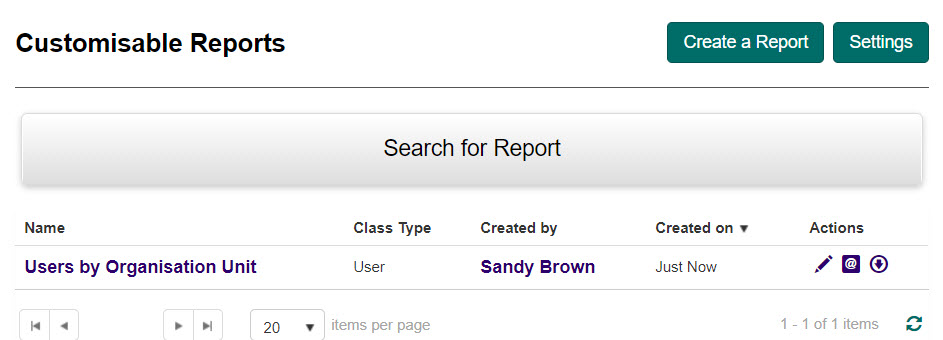
Once you have created a custom report, you have the option to export it to Excel, CSV or PDF format.
To do this select the format you would like to export in from the Export as drop-down field, then select the Export button.
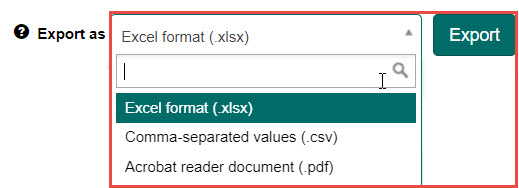
The report will download to your computer/device.
You can schedule reports to email or file to run at specific times or regular intervals.
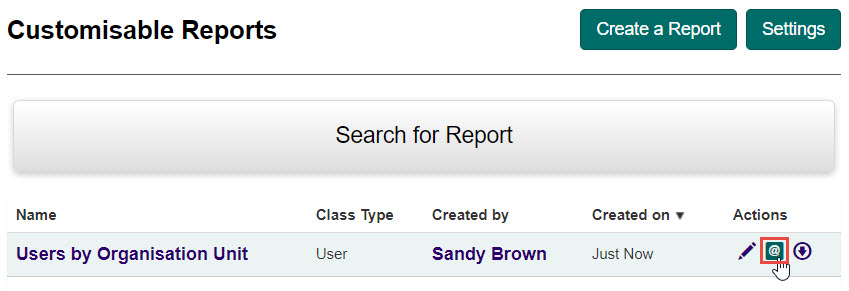
Complete the following:
Tip
Use a semicolon (;) between email addresses to send the report to more than one person.
Tip
If the Schedule Type you select is At a regular interval, you would not typically set an end date as the options set there would determine the end date.
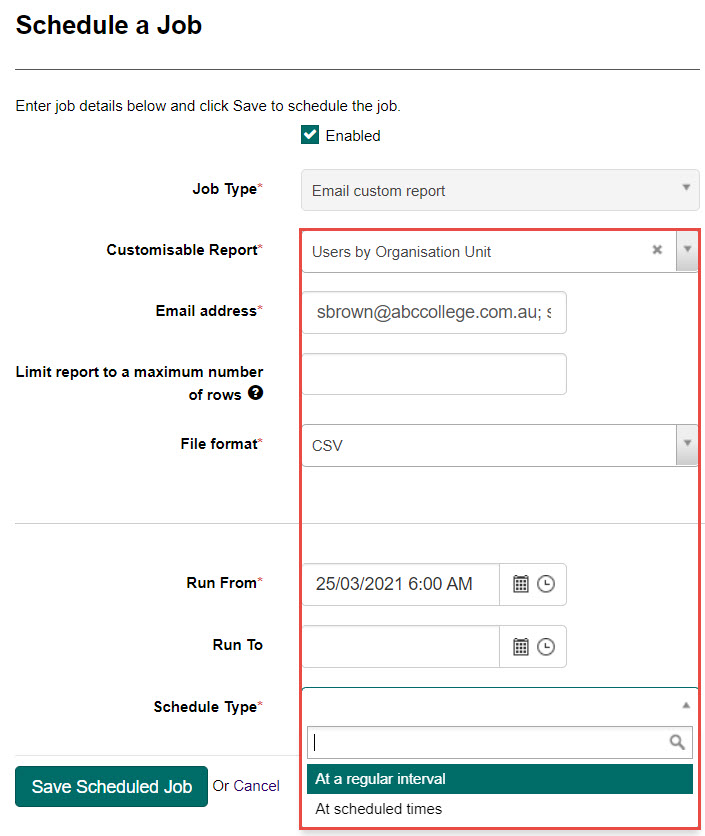
| Schedule type | Description |
|---|---|
| At a regular interval | This report will run at regular intervals. If this option is selected, additional options will display. Complete the following:
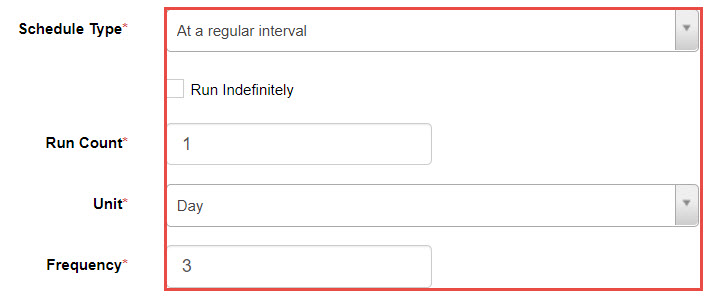 |
| At scheduled times | This report is set to run at scheduled times. If this option is selected, additional options will display. Complete the following:
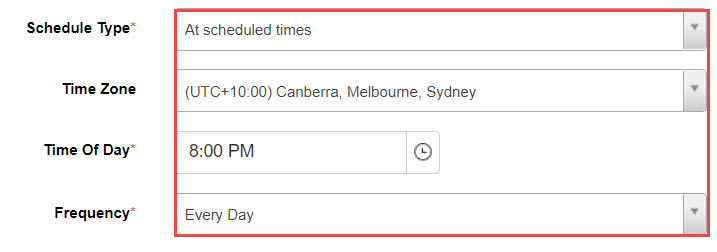 |
Reports can also be scheduled to be placed in a location on the network. This may be used for third party systems such as a HR system to access User data.
To do this:
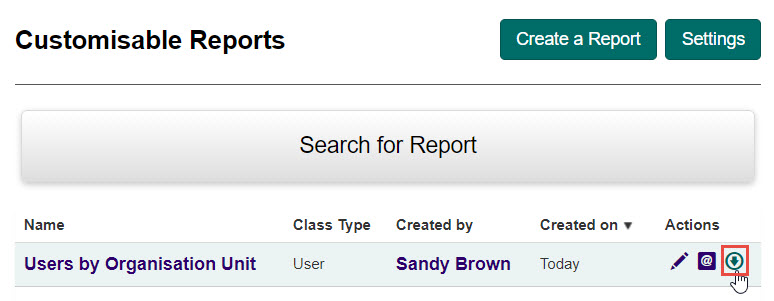
Tip
Use a semicolon (;) between email addresses to send the report to more than one person.
Tip
If the Schedule Type you select is At a regular interval, you would not typically set an end date as the options set there would determine the end date.
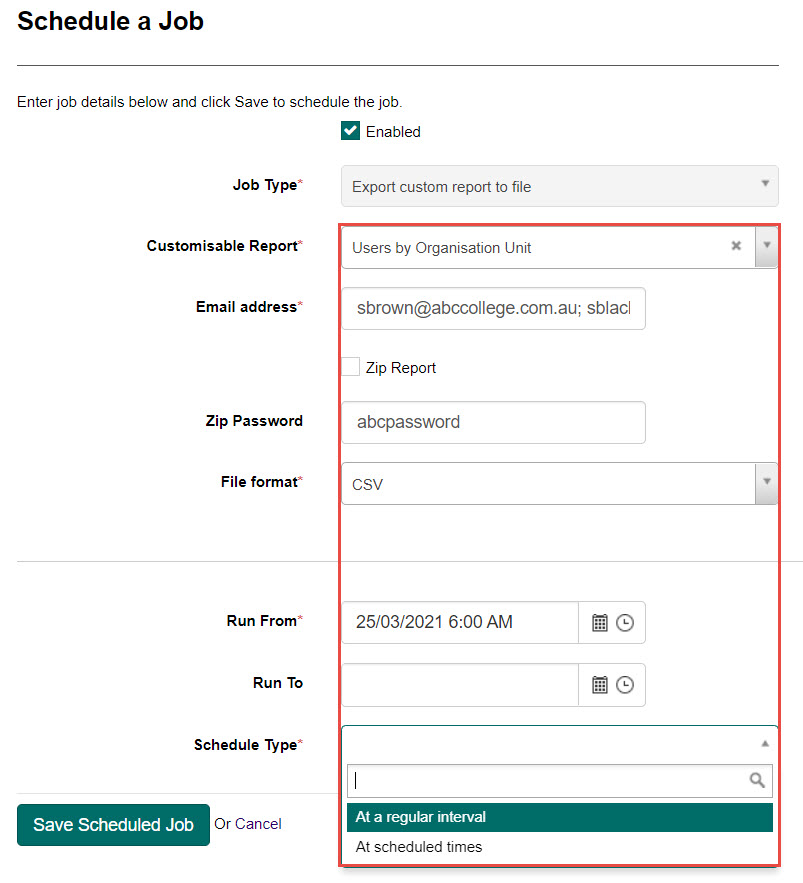
| Schedule type | Description |
|---|---|
| At a regular interval | This report will run at regular intervals. If this option is selected, additional options will display. Complete the following:
 |
| At scheduled times | This report is set to run at scheduled times. If this option is selected, additional options will display. Complete the following:
|
You can use an Excel template to sort, count, total or average data and add charts to your report.
Tip
To use a template, you must have the Enable Excel Template based reports setting enabled in the customisable report settings. To see how to do this, see the Custom report settings section.
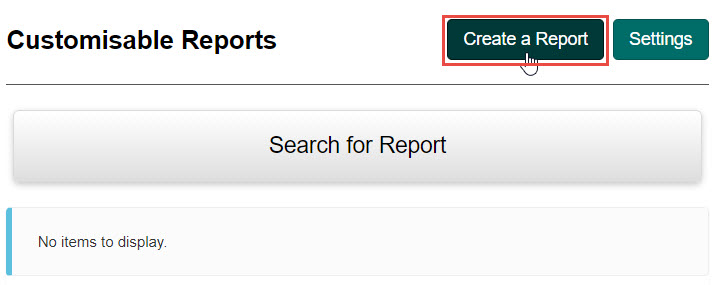
The New Report screen will be displayed.
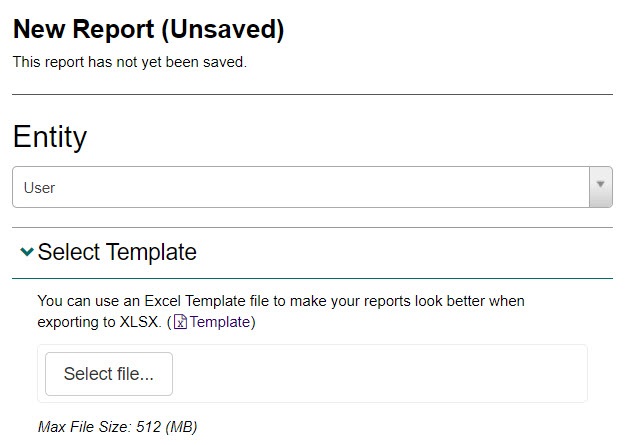
| Schedule type | Description |
|---|---|
| Data template | This is the tab where you input the data you intend to have on your report including:
|
| Raw data | This is the tab which will be populated with the data when the report is run. The columns are the PropertyName from the data template tab.  |
| Chart | This is the tab where you can add a pivot table and charts based on the raw data. 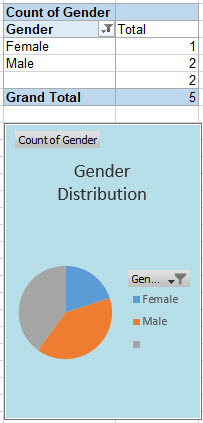 |
1300 857 687 (Australia)
+61 2 6652 9850 (International)
ACN 091 302 975
ABN 35 081 897 494
© 2024 Janison
Janison acknowledges the traditional owners of the land on which we work and meet. We acknowledge the continuous care of the land, animals and waterways. We pay our respects to Elders past, present and emerging.